Financial Analysis of Molson Coors Brewing: Performance Evaluation and Porter's Five Forces
VerifiedAdded on 2023/04/26
|9
|1565
|385
AI Summary
In this report we will discuss about finance and below are the summaries point:-
Analysis of Consumer Goods Molson Coors Brewing using financial statements of 2016-2018.
Evaluation of company's performance through profitability analysis and return on equity.
Examination of Porter's five forces model, including threat of new entrants, bargaining power of buyers and suppliers, and threat of substitutes.
Contribute Materials
Your contribution can guide someone’s learning journey. Share your
documents today.

FINANCE
Secure Best Marks with AI Grader
Need help grading? Try our AI Grader for instant feedback on your assignments.
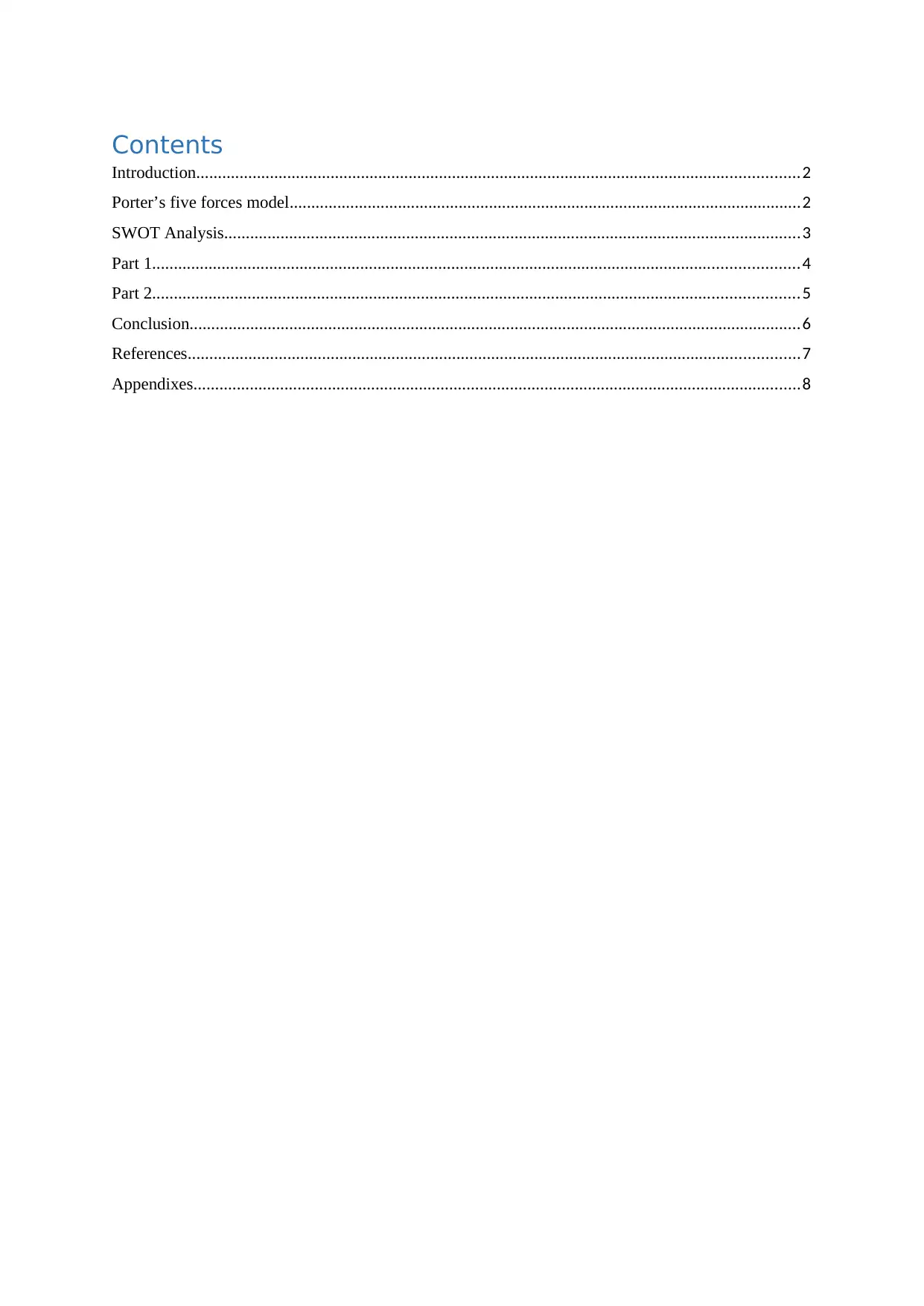
Contents
Introduction...........................................................................................................................................2
Porter’s five forces model......................................................................................................................2
SWOT Analysis.....................................................................................................................................3
Part 1.....................................................................................................................................................4
Part 2.....................................................................................................................................................5
Conclusion.............................................................................................................................................6
References.............................................................................................................................................7
Appendixes............................................................................................................................................8
Introduction...........................................................................................................................................2
Porter’s five forces model......................................................................................................................2
SWOT Analysis.....................................................................................................................................3
Part 1.....................................................................................................................................................4
Part 2.....................................................................................................................................................5
Conclusion.............................................................................................................................................6
References.............................................................................................................................................7
Appendixes............................................................................................................................................8
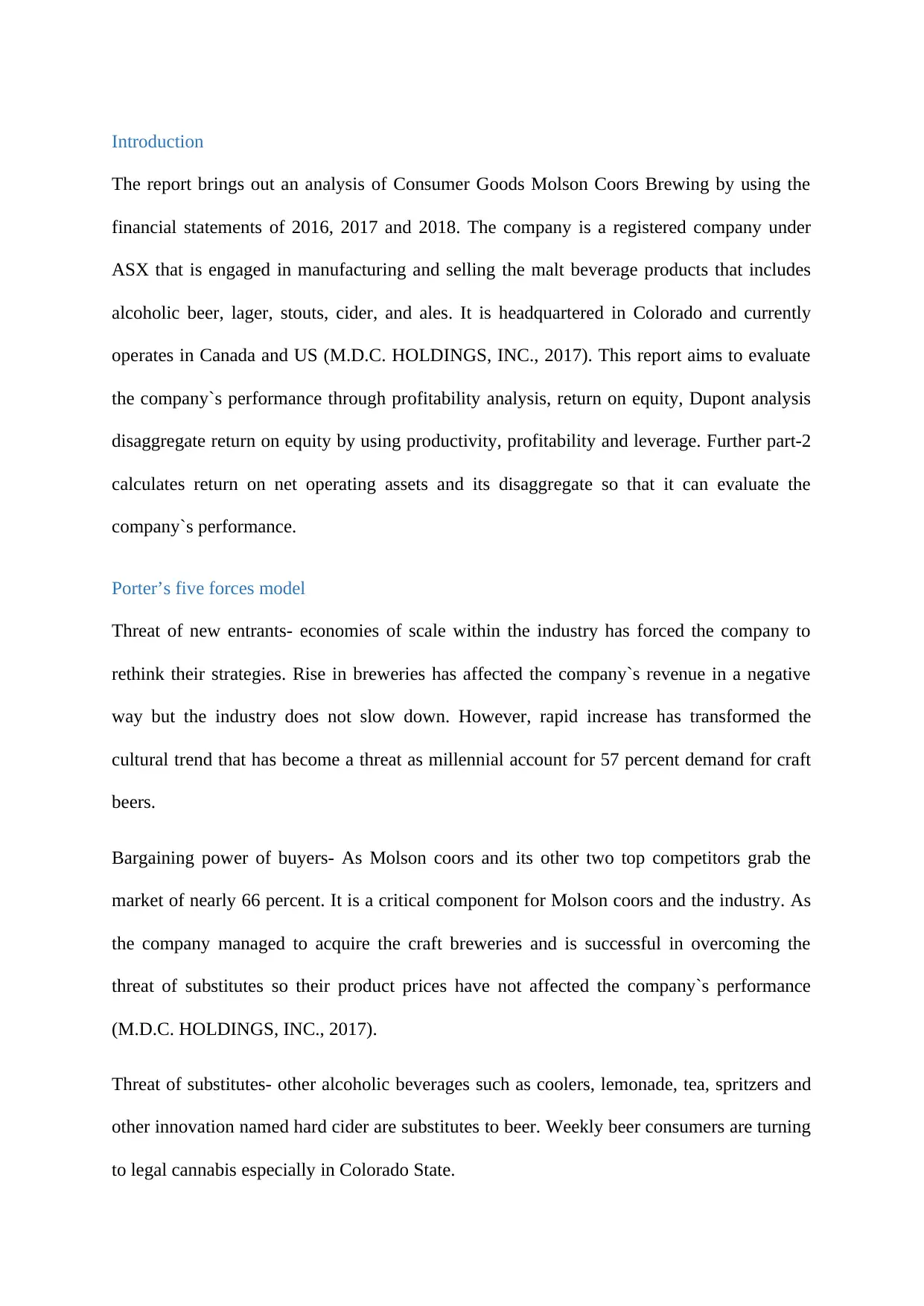
Introduction
The report brings out an analysis of Consumer Goods Molson Coors Brewing by using the
financial statements of 2016, 2017 and 2018. The company is a registered company under
ASX that is engaged in manufacturing and selling the malt beverage products that includes
alcoholic beer, lager, stouts, cider, and ales. It is headquartered in Colorado and currently
operates in Canada and US (M.D.C. HOLDINGS, INC., 2017). This report aims to evaluate
the company`s performance through profitability analysis, return on equity, Dupont analysis
disaggregate return on equity by using productivity, profitability and leverage. Further part-2
calculates return on net operating assets and its disaggregate so that it can evaluate the
company`s performance.
Porter’s five forces model
Threat of new entrants- economies of scale within the industry has forced the company to
rethink their strategies. Rise in breweries has affected the company`s revenue in a negative
way but the industry does not slow down. However, rapid increase has transformed the
cultural trend that has become a threat as millennial account for 57 percent demand for craft
beers.
Bargaining power of buyers- As Molson coors and its other two top competitors grab the
market of nearly 66 percent. It is a critical component for Molson coors and the industry. As
the company managed to acquire the craft breweries and is successful in overcoming the
threat of substitutes so their product prices have not affected the company`s performance
(M.D.C. HOLDINGS, INC., 2017).
Threat of substitutes- other alcoholic beverages such as coolers, lemonade, tea, spritzers and
other innovation named hard cider are substitutes to beer. Weekly beer consumers are turning
to legal cannabis especially in Colorado State.
The report brings out an analysis of Consumer Goods Molson Coors Brewing by using the
financial statements of 2016, 2017 and 2018. The company is a registered company under
ASX that is engaged in manufacturing and selling the malt beverage products that includes
alcoholic beer, lager, stouts, cider, and ales. It is headquartered in Colorado and currently
operates in Canada and US (M.D.C. HOLDINGS, INC., 2017). This report aims to evaluate
the company`s performance through profitability analysis, return on equity, Dupont analysis
disaggregate return on equity by using productivity, profitability and leverage. Further part-2
calculates return on net operating assets and its disaggregate so that it can evaluate the
company`s performance.
Porter’s five forces model
Threat of new entrants- economies of scale within the industry has forced the company to
rethink their strategies. Rise in breweries has affected the company`s revenue in a negative
way but the industry does not slow down. However, rapid increase has transformed the
cultural trend that has become a threat as millennial account for 57 percent demand for craft
beers.
Bargaining power of buyers- As Molson coors and its other two top competitors grab the
market of nearly 66 percent. It is a critical component for Molson coors and the industry. As
the company managed to acquire the craft breweries and is successful in overcoming the
threat of substitutes so their product prices have not affected the company`s performance
(M.D.C. HOLDINGS, INC., 2017).
Threat of substitutes- other alcoholic beverages such as coolers, lemonade, tea, spritzers and
other innovation named hard cider are substitutes to beer. Weekly beer consumers are turning
to legal cannabis especially in Colorado State.

Bargaining power of suppliers- Few suppliers are supermarkets, sponsored events, bars, and
liquor stores that affect the bargaining power of suppliers. It exists according to upstream
operations such as economies of scale and agricultural products.
Threat of rivalry- the company faces competition from Boston beer company, Diageo Plc,
compania Cervecerias Unidas S. A., and Brown Forman Inc Cl A. The rivalry depends on the
type of beer segment such as large ale, boc, dark, and light.
Overall Porter`s five forces avails valuable insight into this industry. Variety packs, seasonal
brews, economies of scale, and consumer pallets force the Consumer Goods Molson Coors
Brewing Company to differentiate the strategy, which can increase the value and grab
opportunities that lie within the product substitutes.
SWOT Analysis
Strengths
The company have the licensing agreement for Canadian market with leading brands such as
Miller Lite, Foster`s, Milwaukee`s best dry, Asahi and Murphy.
It is an innovative company that could even survive after the prohibition in US. In 2007, the
company formed a new advertising campaign to position it among African-American people
(Hunter, 2016).
Weaknesses
It is evaluated from the financial statements that company is dependent on US for its revenue
generation.
It rely on very few brands that is exposed to vulnerability when sales fluctuate.
Opportunities
liquor stores that affect the bargaining power of suppliers. It exists according to upstream
operations such as economies of scale and agricultural products.
Threat of rivalry- the company faces competition from Boston beer company, Diageo Plc,
compania Cervecerias Unidas S. A., and Brown Forman Inc Cl A. The rivalry depends on the
type of beer segment such as large ale, boc, dark, and light.
Overall Porter`s five forces avails valuable insight into this industry. Variety packs, seasonal
brews, economies of scale, and consumer pallets force the Consumer Goods Molson Coors
Brewing Company to differentiate the strategy, which can increase the value and grab
opportunities that lie within the product substitutes.
SWOT Analysis
Strengths
The company have the licensing agreement for Canadian market with leading brands such as
Miller Lite, Foster`s, Milwaukee`s best dry, Asahi and Murphy.
It is an innovative company that could even survive after the prohibition in US. In 2007, the
company formed a new advertising campaign to position it among African-American people
(Hunter, 2016).
Weaknesses
It is evaluated from the financial statements that company is dependent on US for its revenue
generation.
It rely on very few brands that is exposed to vulnerability when sales fluctuate.
Opportunities
Secure Best Marks with AI Grader
Need help grading? Try our AI Grader for instant feedback on your assignments.

The company should enter Asian beer market as it provides many opportunities for business
expansion (Jenson, 2018).
Strategic alliances can help the company to reduce the risk while moving into the foreign
countries.
Threats
Piercing competition from the top competitors such as Ashai, Herineken, Tsingtao, and Kirin.
Economic recession in US economy has increased the sale of beer first but in long run, it was
reduced (Jenson, 2018).
Part 1
Calculation of return on equity
From the above calculation, it can be interpreted that Return on equity has been improved in
2017 as compared to 2016. Increase in return on equity have few reasons such as increase in
sales and net income. Although the number of equity shareholders have increased which
indicates that the company is successful in maintaining its return to each holder during 2017
(corporatefinanceinstitute, 2018). In 2018, the company is serving very well to its
shareholders. Du-pont Analysis shows the ability of the company to increase the return on
equity (M.D.C. HOLDINGS, INC., 2018). It is an expression where organisation`s return of
equity is represented as a multiplication of profit margin, return on equity, total asset turnover
and the equity multiplier. From the analysis continued in the excel sheet, the return on equity
has shown an increase in 2018 as compared to 2017 and 2016 (M.D.C. HOLDINGS, INC.,
2018). The return for equity has been increased due to increase in net profitability, net asset
turnover, and the equity multiplier. Each element of Du-point Analysis reflects an increase
even individually that kept multiplying and increased the return on equity (Hunter, 2016).
expansion (Jenson, 2018).
Strategic alliances can help the company to reduce the risk while moving into the foreign
countries.
Threats
Piercing competition from the top competitors such as Ashai, Herineken, Tsingtao, and Kirin.
Economic recession in US economy has increased the sale of beer first but in long run, it was
reduced (Jenson, 2018).
Part 1
Calculation of return on equity
From the above calculation, it can be interpreted that Return on equity has been improved in
2017 as compared to 2016. Increase in return on equity have few reasons such as increase in
sales and net income. Although the number of equity shareholders have increased which
indicates that the company is successful in maintaining its return to each holder during 2017
(corporatefinanceinstitute, 2018). In 2018, the company is serving very well to its
shareholders. Du-pont Analysis shows the ability of the company to increase the return on
equity (M.D.C. HOLDINGS, INC., 2018). It is an expression where organisation`s return of
equity is represented as a multiplication of profit margin, return on equity, total asset turnover
and the equity multiplier. From the analysis continued in the excel sheet, the return on equity
has shown an increase in 2018 as compared to 2017 and 2016 (M.D.C. HOLDINGS, INC.,
2018). The return for equity has been increased due to increase in net profitability, net asset
turnover, and the equity multiplier. Each element of Du-point Analysis reflects an increase
even individually that kept multiplying and increased the return on equity (Hunter, 2016).
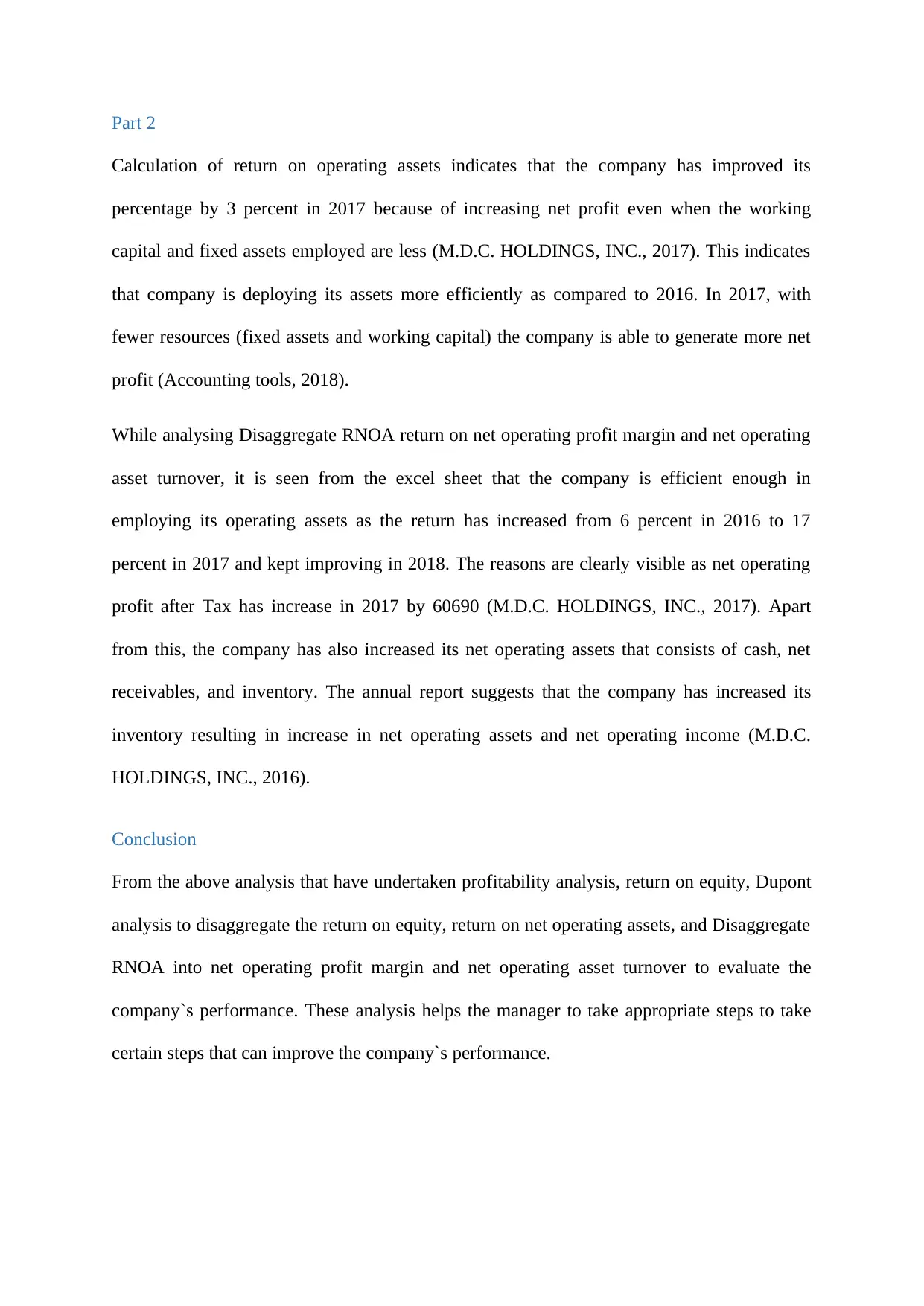
Part 2
Calculation of return on operating assets indicates that the company has improved its
percentage by 3 percent in 2017 because of increasing net profit even when the working
capital and fixed assets employed are less (M.D.C. HOLDINGS, INC., 2017). This indicates
that company is deploying its assets more efficiently as compared to 2016. In 2017, with
fewer resources (fixed assets and working capital) the company is able to generate more net
profit (Accounting tools, 2018).
While analysing Disaggregate RNOA return on net operating profit margin and net operating
asset turnover, it is seen from the excel sheet that the company is efficient enough in
employing its operating assets as the return has increased from 6 percent in 2016 to 17
percent in 2017 and kept improving in 2018. The reasons are clearly visible as net operating
profit after Tax has increase in 2017 by 60690 (M.D.C. HOLDINGS, INC., 2017). Apart
from this, the company has also increased its net operating assets that consists of cash, net
receivables, and inventory. The annual report suggests that the company has increased its
inventory resulting in increase in net operating assets and net operating income (M.D.C.
HOLDINGS, INC., 2016).
Conclusion
From the above analysis that have undertaken profitability analysis, return on equity, Dupont
analysis to disaggregate the return on equity, return on net operating assets, and Disaggregate
RNOA into net operating profit margin and net operating asset turnover to evaluate the
company`s performance. These analysis helps the manager to take appropriate steps to take
certain steps that can improve the company`s performance.
Calculation of return on operating assets indicates that the company has improved its
percentage by 3 percent in 2017 because of increasing net profit even when the working
capital and fixed assets employed are less (M.D.C. HOLDINGS, INC., 2017). This indicates
that company is deploying its assets more efficiently as compared to 2016. In 2017, with
fewer resources (fixed assets and working capital) the company is able to generate more net
profit (Accounting tools, 2018).
While analysing Disaggregate RNOA return on net operating profit margin and net operating
asset turnover, it is seen from the excel sheet that the company is efficient enough in
employing its operating assets as the return has increased from 6 percent in 2016 to 17
percent in 2017 and kept improving in 2018. The reasons are clearly visible as net operating
profit after Tax has increase in 2017 by 60690 (M.D.C. HOLDINGS, INC., 2017). Apart
from this, the company has also increased its net operating assets that consists of cash, net
receivables, and inventory. The annual report suggests that the company has increased its
inventory resulting in increase in net operating assets and net operating income (M.D.C.
HOLDINGS, INC., 2016).
Conclusion
From the above analysis that have undertaken profitability analysis, return on equity, Dupont
analysis to disaggregate the return on equity, return on net operating assets, and Disaggregate
RNOA into net operating profit margin and net operating asset turnover to evaluate the
company`s performance. These analysis helps the manager to take appropriate steps to take
certain steps that can improve the company`s performance.
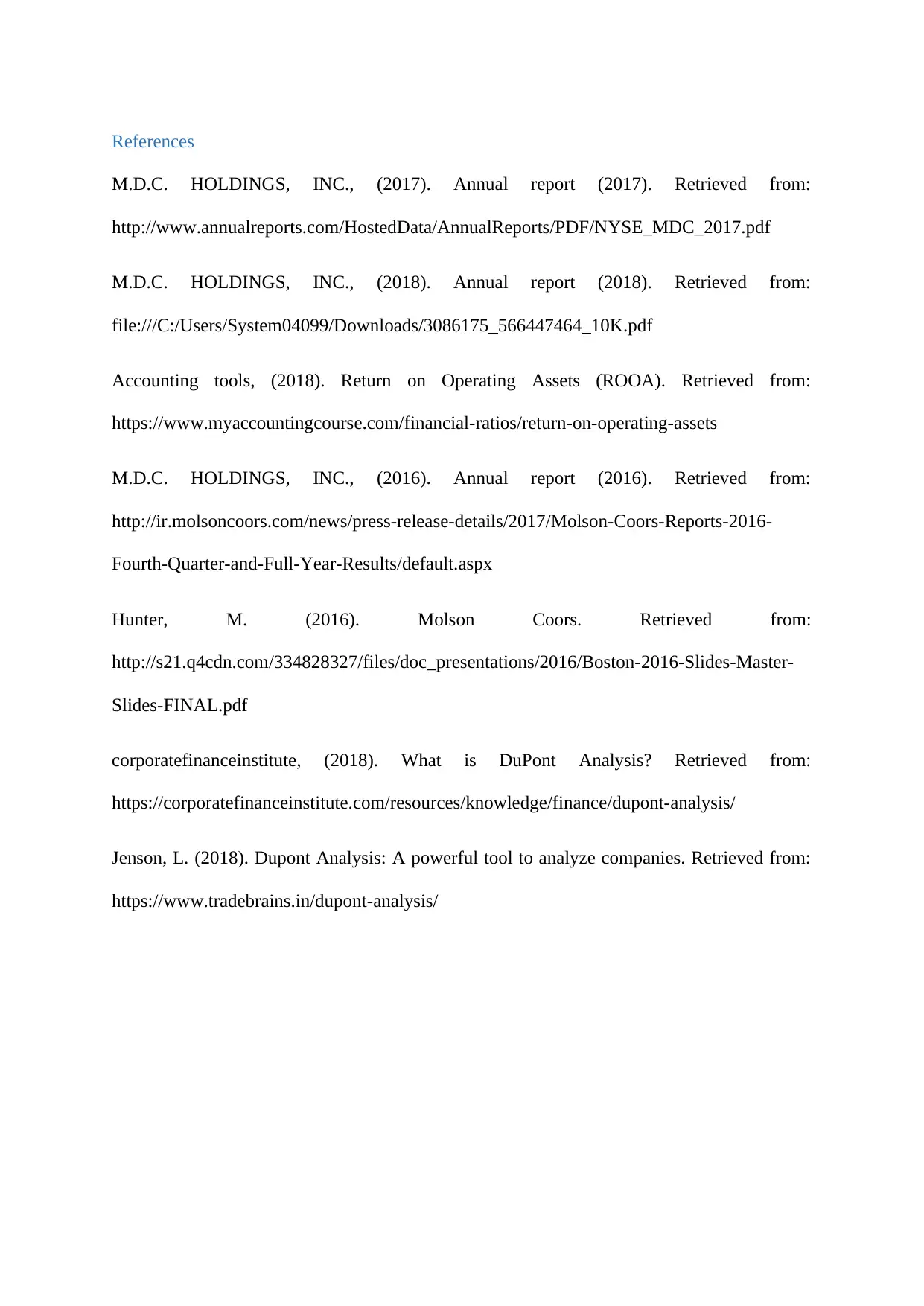
References
M.D.C. HOLDINGS, INC., (2017). Annual report (2017). Retrieved from:
http://www.annualreports.com/HostedData/AnnualReports/PDF/NYSE_MDC_2017.pdf
M.D.C. HOLDINGS, INC., (2018). Annual report (2018). Retrieved from:
file:///C:/Users/System04099/Downloads/3086175_566447464_10K.pdf
Accounting tools, (2018). Return on Operating Assets (ROOA). Retrieved from:
https://www.myaccountingcourse.com/financial-ratios/return-on-operating-assets
M.D.C. HOLDINGS, INC., (2016). Annual report (2016). Retrieved from:
http://ir.molsoncoors.com/news/press-release-details/2017/Molson-Coors-Reports-2016-
Fourth-Quarter-and-Full-Year-Results/default.aspx
Hunter, M. (2016). Molson Coors. Retrieved from:
http://s21.q4cdn.com/334828327/files/doc_presentations/2016/Boston-2016-Slides-Master-
Slides-FINAL.pdf
corporatefinanceinstitute, (2018). What is DuPont Analysis? Retrieved from:
https://corporatefinanceinstitute.com/resources/knowledge/finance/dupont-analysis/
Jenson, L. (2018). Dupont Analysis: A powerful tool to analyze companies. Retrieved from:
https://www.tradebrains.in/dupont-analysis/
M.D.C. HOLDINGS, INC., (2017). Annual report (2017). Retrieved from:
http://www.annualreports.com/HostedData/AnnualReports/PDF/NYSE_MDC_2017.pdf
M.D.C. HOLDINGS, INC., (2018). Annual report (2018). Retrieved from:
file:///C:/Users/System04099/Downloads/3086175_566447464_10K.pdf
Accounting tools, (2018). Return on Operating Assets (ROOA). Retrieved from:
https://www.myaccountingcourse.com/financial-ratios/return-on-operating-assets
M.D.C. HOLDINGS, INC., (2016). Annual report (2016). Retrieved from:
http://ir.molsoncoors.com/news/press-release-details/2017/Molson-Coors-Reports-2016-
Fourth-Quarter-and-Full-Year-Results/default.aspx
Hunter, M. (2016). Molson Coors. Retrieved from:
http://s21.q4cdn.com/334828327/files/doc_presentations/2016/Boston-2016-Slides-Master-
Slides-FINAL.pdf
corporatefinanceinstitute, (2018). What is DuPont Analysis? Retrieved from:
https://corporatefinanceinstitute.com/resources/knowledge/finance/dupont-analysis/
Jenson, L. (2018). Dupont Analysis: A powerful tool to analyze companies. Retrieved from:
https://www.tradebrains.in/dupont-analysis/
Paraphrase This Document
Need a fresh take? Get an instant paraphrase of this document with our AI Paraphraser
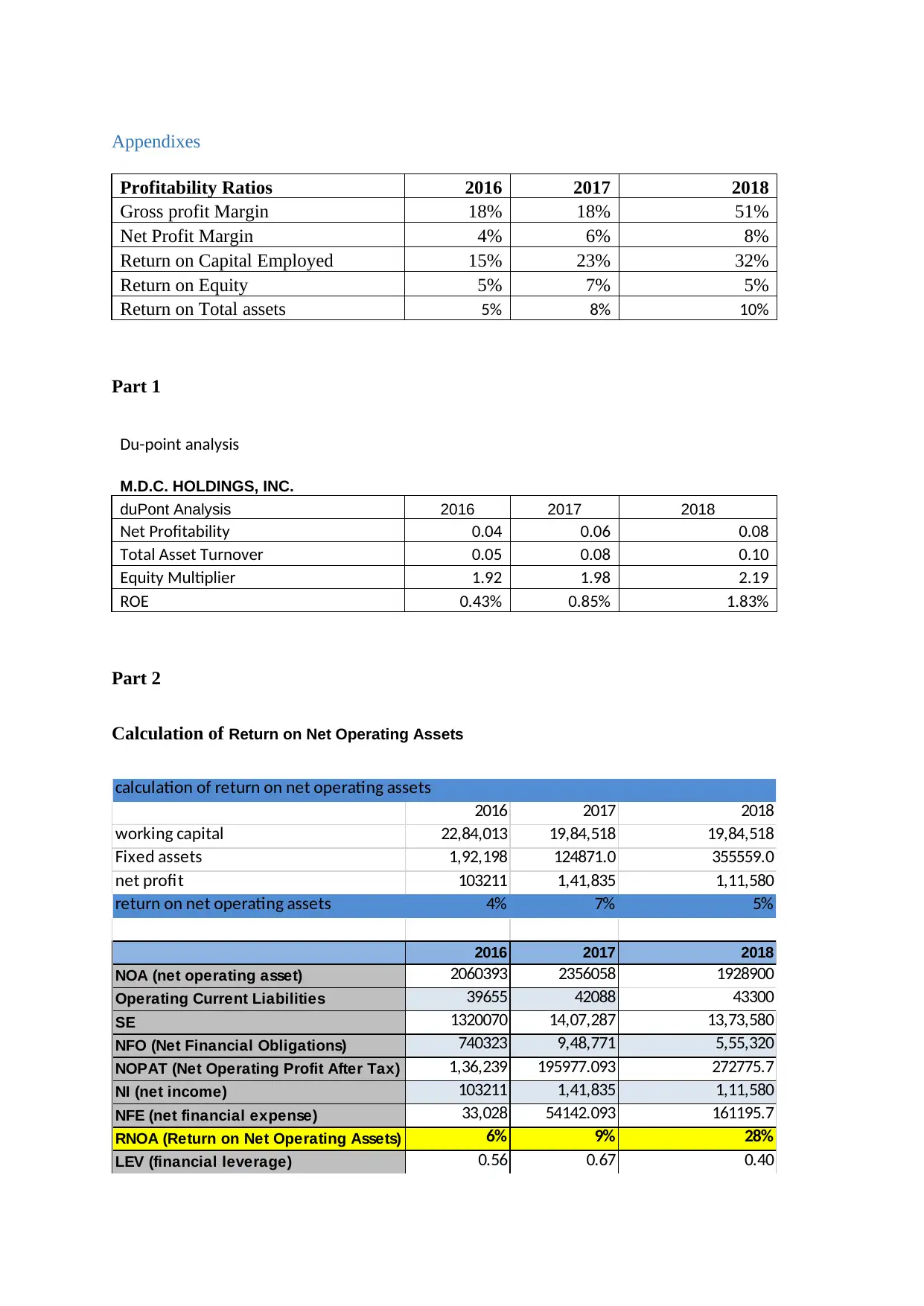
Appendixes
Profitability Ratios 2016 2017 2018
Gross profit Margin 18% 18% 51%
Net Profit Margin 4% 6% 8%
Return on Capital Employed 15% 23% 32%
Return on Equity 5% 7% 5%
Return on Total assets 5% 8% 10%
Part 1
Du-point analysis
M.D.C. HOLDINGS, INC.
duPont Analysis 2016 2017 2018
Net Profitability 0.04 0.06 0.08
Total Asset Turnover 0.05 0.08 0.10
Equity Multiplier 1.92 1.98 2.19
ROE 0.43% 0.85% 1.83%
Part 2
Calculation of Return on Net Operating Assets
calculation of return on net operating assets
2016 2017 2018
working capital 22,84,013 19,84,518 19,84,518
Fixed assets 1,92,198 124871.0 355559.0
net profit 103211 1,41,835 1,11,580
return on net operating assets 4% 7% 5%
2016 2017 2018
NOA (net operating asset) 2060393 2356058 1928900
Operating Current Liabilities 39655 42088 43300
SE 1320070 14,07,287 13,73,580
NFO (Net Financial Obligations) 740323 9,48,771 5,55,320
NOPAT (Net Operating Profit After Tax) 1,36,239 195977.093 272775.7
NI (net income) 103211 1,41,835 1,11,580
NFE (net financial expense) 33,028 54142.093 161195.7
RNOA (Return on Net Operating Assets) 6% 9% 28%
LEV (financial leverage) 0.56 0.67 0.40
Profitability Ratios 2016 2017 2018
Gross profit Margin 18% 18% 51%
Net Profit Margin 4% 6% 8%
Return on Capital Employed 15% 23% 32%
Return on Equity 5% 7% 5%
Return on Total assets 5% 8% 10%
Part 1
Du-point analysis
M.D.C. HOLDINGS, INC.
duPont Analysis 2016 2017 2018
Net Profitability 0.04 0.06 0.08
Total Asset Turnover 0.05 0.08 0.10
Equity Multiplier 1.92 1.98 2.19
ROE 0.43% 0.85% 1.83%
Part 2
Calculation of Return on Net Operating Assets
calculation of return on net operating assets
2016 2017 2018
working capital 22,84,013 19,84,518 19,84,518
Fixed assets 1,92,198 124871.0 355559.0
net profit 103211 1,41,835 1,11,580
return on net operating assets 4% 7% 5%
2016 2017 2018
NOA (net operating asset) 2060393 2356058 1928900
Operating Current Liabilities 39655 42088 43300
SE 1320070 14,07,287 13,73,580
NFO (Net Financial Obligations) 740323 9,48,771 5,55,320
NOPAT (Net Operating Profit After Tax) 1,36,239 195977.093 272775.7
NI (net income) 103211 1,41,835 1,11,580
NFE (net financial expense) 33,028 54142.093 161195.7
RNOA (Return on Net Operating Assets) 6% 9% 28%
LEV (financial leverage) 0.56 0.67 0.40

1 out of 9
Related Documents
Your All-in-One AI-Powered Toolkit for Academic Success.
+13062052269
info@desklib.com
Available 24*7 on WhatsApp / Email
![[object Object]](/_next/static/media/star-bottom.7253800d.svg)
Unlock your academic potential
© 2024 | Zucol Services PVT LTD | All rights reserved.





